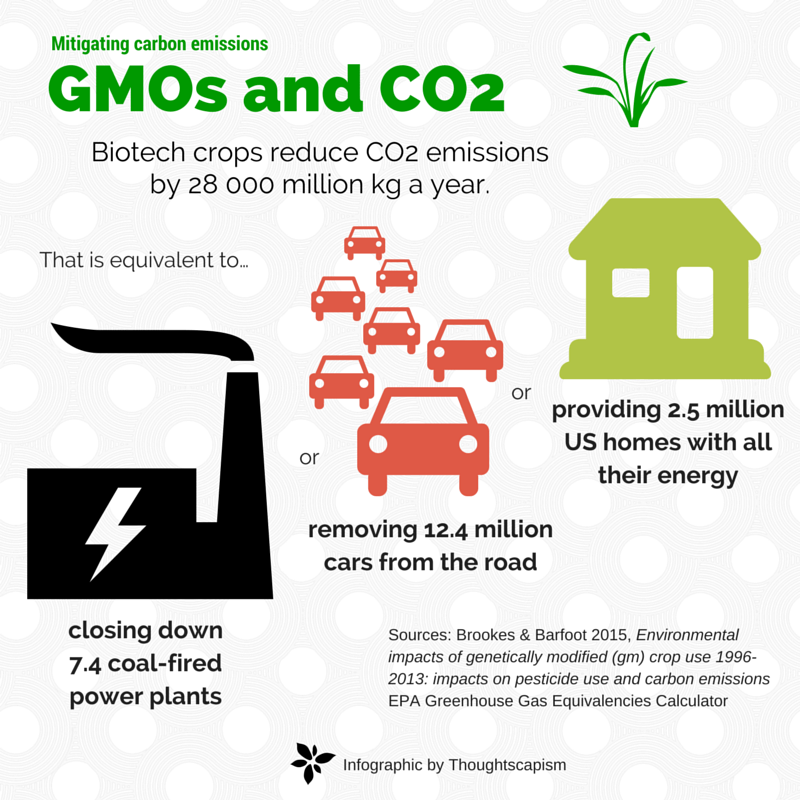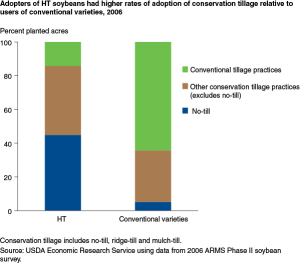Many people are worried about the impact GMOs could have on the environment. That’s a reasonable concern. Are GMOs increasing the profits of farmers and biotech companies at the expense of the environment? As I have learned more about biotechnology and agriculture, contrary to popular fear, I have found that there is actually no scientific evidence of harm from GMOs – but it doesn’t stop there. Conversely, I have learned that there are several environmental benefits of biotechnology.

So what does the environment have to gain from biotechnology? I have touched on this topic before, in my piece On farming, animals, and the environment from an organic farming angle, but I believe it deserves a post of its own. Shortly put, GMO crops have been found to increase farming efficiency: higher yields, reduced pesticide use, increased profits, and reduced farm labour.
GMOs help farmers make the best possible use of the land area used for farming. Does that mean that they are using the land somehow too efficiently, resulting in drawbacks for the environment? Not really. Farmers continue working their land for generations. What is best for them is a land that stays healthy and soil that retains its nutrients. On top of that, there are good arguments for farm efficiency being a good measure of its impact on climate change. To clarify what efficiency means in practice, I’ll borrow Marc Brazeau’s words here from Genetic Literacy Project:
High yields are an indicator of efficient use of resources. High yields indicate that water, fuel, fertilizer, pesticides, labor, etc were successfully transformed into food instead of weeds, bug food, and run off.
In our carbon conscious world, most people would consider it a great feat if a large western country such as the UK would manage to cut its car use by more than a third. This is what biotech crops have been doing since 1996 – cutting carbon emissions, in 2013 by as much as 28,000 million kg, or by as much as emitted by 7.4 coal-fired power plants in one year. (Unfortunately none of the biotech-derived carbon savings originate from UK as of yet, however.)
Among the countries responsible for these carbon savings are U.S., Brazil, Argentina, China, India, Bolivia, Paraguay, Uruguay, South Africa, and Canada. European countries on the other hand, have been slow to adopt biotechnology, but with five EU countries growing GMO maize at present, and a total of 49 GMO crops authorised for use all in all, Europe (and the UK) could soon begin taking part of these advances.
You can read more in the report by European Academies Science Advisory Council (ESAC):
Taken together, the published evidence indicates that, if used properly, adoption of these crops can be associated with the following:
• reduced environmental impact of herbicides and insecticides;
• no/reduced tillage production systems with concomitant reduction in soil erosion;
• economic and health benefit at the farm level, particularly to smallholder farmers in developing countries;
• reduction in greenhouse gas emissions from agricultural practices.
Below you can find the sources for the data in my infographic. They present the key environmental impacts that crop biotechnology has had on global agriculture in two studies from 2014 and 2015. Their summary:
The adoption of GM insect resistant and herbicide tolerant technology has reduced pesticide spraying by 553 million kg (-8.6 percent) and, as a result, decreased the environmental impact associated with herbicide and insecticide use on these crops (as measured by the indicator the Environmental Impact Quotient (EIQ)) by 19.1 percent. The technology has also facilitated important cuts in fuel use and tillage changes, resulting in a significant reduction in the release of greenhouse gas emissions from the GM cropping area. In 2013, this was equivalent to removing 12.4 million cars from the roads.
They note in the paper that reduced levels of greenhouse gas emissions follow largely from reduced tractor fuel use and additional carbon retained in the soil. So what about GMO farming leads to increased soil organic matter (carbon sequestration)? One of the big benefits is the wider adoption of the no-till method, also known as conservation tillage, which means omitting the plowing or tilling step (a crude means of weed management). The U.S. Department of Agriculture notes that the spread of the no-till method is largely thanks to the adoption of Herbicide Tolerant (HT) crop varieties.
These trends suggest that HT crop adoption facilitates the use of conservation tillage practices. In addition, a review of several econometric studies points to a two-way causal relationship between the adoption of HT crops and conservation tillage. Thus, in addition to its direct effects on herbicide usage, adoption of herbicide-tolerant crops indirectly benefits the environment by encouraging the use of conservation tillage.
 Many people may immediately think of pesticide use as the burdensome factor when environmental aspects of farming are mentioned. While GMOs have helped reduce pesticide use, this is actually quite a small part among the ecological impacts of agriculture. As Marc Brazeau puts it over at Food and Farm Discussion Lab:
Many people may immediately think of pesticide use as the burdensome factor when environmental aspects of farming are mentioned. While GMOs have helped reduce pesticide use, this is actually quite a small part among the ecological impacts of agriculture. As Marc Brazeau puts it over at Food and Farm Discussion Lab:
… pesticides represent a drop in the sustainability bucket when compared to land use, water use, pollution and greenhouse gases. In fact, it may seem counter-intuitive but, pesticides can play a substantial role in mitigating the damage associated with many of those other factors.
These big factors are highlighted in a report published in Science in 2014 (discussed in more depth in the Food and Farm piece above):
We find that a relatively small set of places and actions could provide enough new calories to meet the basic needs for more than 3 billion people, address many environmental impacts with global consequences, and focus food waste reduction on the commodities with the greatest impact on food security.
That sounds encouraging. All in all, science is good news for both farmers, consumers, and the environment. We need every tool in the box to help with the precarious balancing act of human welfare intricately interwoven with the welfare of the environment.
Iida Ruishalme is a writer and a science communicator who holds a M.Sc. in Biology from Sweden. She blogs over at Thoughtscapism. Follow her on twitter: @Thoughtscapism or on her Facebook page.































